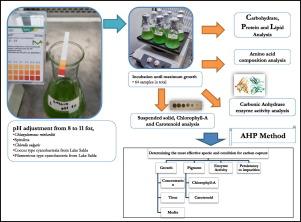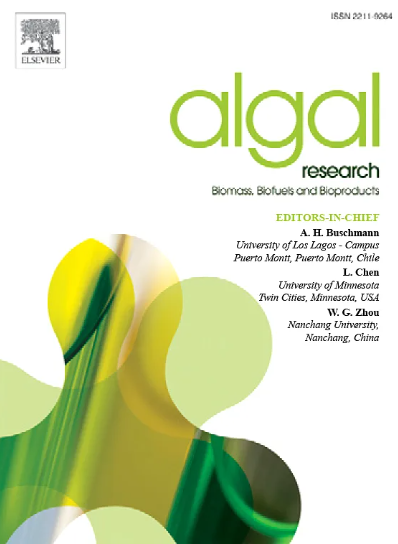不同微藻物种在碱性 pH 值下的碳酸酐酶活性和代谢物变化
IF 4.6
2区 生物学
Q1 BIOTECHNOLOGY & APPLIED MICROBIOLOGY
Algal Research-Biomass Biofuels and Bioproducts
Pub Date : 2024-11-05
DOI:10.1016/j.algal.2024.103778
引用次数: 0
摘要
上个世纪,大气中的温室气体大幅增加,促使人们开发了多种去除二氧化碳(CO2)的方法和技术。微生物通过二氧化碳的自然矿化产生碳酸盐矿物,但这一过程的可行性仍在研究之中。这项工作旨在研究不同微藻在碱性 pH 值条件下的培养情况,以保持其碳减排潜力。结果表明,在 pH 值为 10 时,莱茵衣藻的碳酸酐酶活性最高(4.64 毫克/克)。在 pH 值为 9.5 时,绿衣藻的叶绿素含量最高(23.58 毫克/克),而在 pH 值为 8.5 时,螺旋藻的生物量最高(882.9 毫克/升)。此外,pH 值与 C. reinhardtii 的脂质含量呈正相关。而螺旋藻则表现出相反的效果。根据主成分分析,萨尔达湖蓝藻和丝状蓝藻的 pH 值与碳酸酐酶(CA)活性之间存在相反的关系。根据层次分析法(Analytic hierarchy process method),微藻物种对高碳捕获的适宜性排序如下:螺旋藻> C. reinhardtii > Chlorella vulgaris > Coccus-type cyanobacteria > 来自萨尔达湖的丝状蓝藻。此外,该研究还提供了有关从碱性湖泊萨尔达湖中分离出的蓝藻物种的重要结果。这将有助于今后对碳捕获和碳减排机制的研究。本文章由计算机程序翻译,如有差异,请以英文原文为准。

Carbonic anhydrase activity and metabolite variation of different microalgae species at alkaline pHs
A significant increase in atmospheric greenhouse gases over the last century has led to the development of several methods and technologies to remove carbon dioxide (CO2). Microorganisms produce carbonate minerals through the natural mineralization of CO2; however, the feasibility of this process remains in research. This work aimed to study the cultivation of different microalgae under alkaline pH to maintain their potential for carbon mitigation. According to the results, the highest carbonic anhydrase activity has been reached (4.64 mg/g) for Chlamydomonas reinhardtii at a pH of 10. C. reinhardtii, at a pH of 9.5, yielded the highest chlorophyll content (23.58 mg/g), while Spirulina at a pH of 8.5 produced the highest biomass (882.9 mg/L). Also, a positive correlation existed between pH and lipid content for C. reinhardtii. Spirulina, however, exhibits the opposite effect. According to a principal component analysis, there is an opposite relationship between pH and carbonic anhydrase (CA) activity for C. reinhardtii and filamentous-type cyanobacteria from Salda Lake. The following order of the suitability of the microalgae species for high carbon capture is determined by the Analytic hierarchy process method: Spirulina> C. reinhardtii > Chlorella vulgaris > Coccus-type cyanobacteria > Filamentous-type cyanobacteria from Salda Lake. Additionally, this study provided important results regarding the cyanobacteria species isolated from an alkaline lake, Lake Salda. This would contribute to future studies of carbon capture and carbon mitigation mechanisms.
求助全文
通过发布文献求助,成功后即可免费获取论文全文。
去求助
来源期刊

Algal Research-Biomass Biofuels and Bioproducts
BIOTECHNOLOGY & APPLIED MICROBIOLOGY-
CiteScore
9.40
自引率
7.80%
发文量
332
期刊介绍:
Algal Research is an international phycology journal covering all areas of emerging technologies in algae biology, biomass production, cultivation, harvesting, extraction, bioproducts, biorefinery, engineering, and econometrics. Algae is defined to include cyanobacteria, microalgae, and protists and symbionts of interest in biotechnology. The journal publishes original research and reviews for the following scope: algal biology, including but not exclusive to: phylogeny, biodiversity, molecular traits, metabolic regulation, and genetic engineering, algal cultivation, e.g. phototrophic systems, heterotrophic systems, and mixotrophic systems, algal harvesting and extraction systems, biotechnology to convert algal biomass and components into biofuels and bioproducts, e.g., nutraceuticals, pharmaceuticals, animal feed, plastics, etc. algal products and their economic assessment
 求助内容:
求助内容: 应助结果提醒方式:
应助结果提醒方式:


